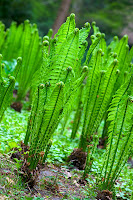Vascular cryptogams and are the first vascular land plants. The main plant body is the sporophyte, which is differentiated into true roots, stems and leaves. Their xylem is lack of companion cells. The sporophytes reproduce by spores, borne in sporangia. Sporangia are usually borne on fertile leaves called sporophylls. Pteridophytes are mostly homosporous, but some are heterosporous with microspores and megaspores.
These plants are vascular, and they have seeds, like the gymnosperms. The add on that makes them so advanced is their ability to have flowers. The main advantage of the flower is to protect the plant’s seeds. Unlike gymnosperms, whose seeds are exposed to weather, animals, and people, angiosperms have their seeds surrounded by flowers, which can offer incredible protection. Many angiosperms have an inner layer that surrounds the seed, storing food and protecting the seed from harm, and an outer layer that protects the seed from the elements or animal attacks.
Bryophytes are simple, green, land plants. Unlike higher plants such as ferns and flowers, they lack specialised woody water conducting vessels. Their relatively delicate, nonvascular structure limits the size to which they can grow. Bryophytes are nonvascular terrestrial plants that first emerged about 420 million years ago. They form the nonmonophyletic grouping Bryophyta and include mosses (Bryophyta), liverworts (Hepatophyta) and hornworts (Anthocerotophyta).
Gymnosperms are naked seeded spermatophytes, originated 350 millions years ago. Most of them have become extinct and some are represented by a few living species called living fossils. The main plant body is the diploid sporophyte, which is woody and perennial and differentiated into root, stem and leaves.
http://www.preservearticles.com/201101102902/gymnosperms.html
http://bryophytes.plant.siu.edu/bryojustified.html
http://www.wisegeek.com/what-are-angiosperms.htm
http://www.preservearticles.com/201101102901/pteridophytes.html
Images from google




No comments:
Post a Comment